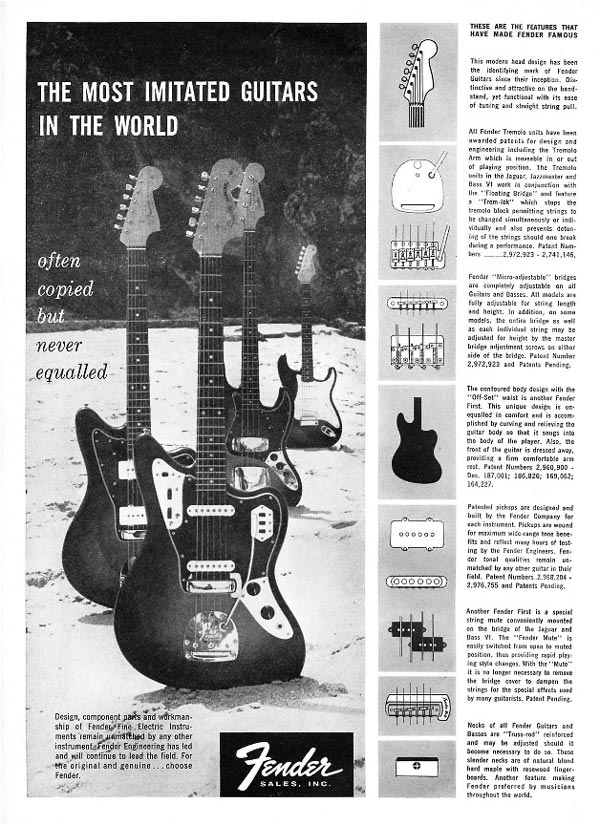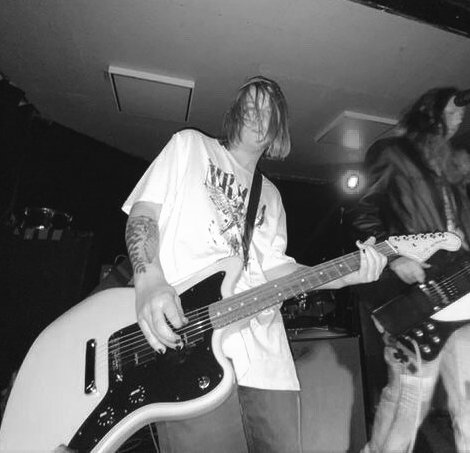

| WHY? An outcast misfit guitarist explains.... |
|
So this page is kind of like those old F.A.Q. (Frequently Asked Questions) Pages regarding why I had to make a separate section of the site for "offset guitars", when in reality, the only real difference (for a lot of the newer variants especially) is a body shape? Well, I"m here to introduce to you a bunch of "whys" on these instruments...
Why Offets? What Makes them Unique  Offset guitars started with Fender Guitars back in the 1950's when Leo Fender decided to design 2 new instruments to compete with Gibson in the "Jazz Guitar" market as a lot of people call it. Back then, Fender, Leo in particular, liked to design a new model with unique features for each iteration of his "Spanish Style Solidbody Electric" instruments, and as such, each instrument was carefully designed specifically for the market for which it was intended, and with each iteration, the markets got a little more compartmentalized. By the time of the Student Models was when I think this started. The Telecaster/Esquire and Stratocaster were designed generally as a "general purpose" instrument, with Telecasters taking up dominance in Country and Rock N' Roll mostly, and the Stratocaster being mostly a "Rock N' Roll" instrument thanks to Buddy Holley at the time being it's biggest user. While the Student models were aimed at "well heeled" beginners and women/teenagers/people of smaller stature with their shorter 22.5" Scale length necks and smaller body shapes. The Jazzmaster was intended for the Jazz market, as was the Jaguar somewhat by extention. However, as the specialization of Fender's products got more extreme, the less popular those products were. THough some cases, like the Mustang, these instruments were tremendously popular but were somewhat inhibited in popularity on a higher level due to their "Student" status.
Offset guitars started with Fender Guitars back in the 1950's when Leo Fender decided to design 2 new instruments to compete with Gibson in the "Jazz Guitar" market as a lot of people call it. Back then, Fender, Leo in particular, liked to design a new model with unique features for each iteration of his "Spanish Style Solidbody Electric" instruments, and as such, each instrument was carefully designed specifically for the market for which it was intended, and with each iteration, the markets got a little more compartmentalized. By the time of the Student Models was when I think this started. The Telecaster/Esquire and Stratocaster were designed generally as a "general purpose" instrument, with Telecasters taking up dominance in Country and Rock N' Roll mostly, and the Stratocaster being mostly a "Rock N' Roll" instrument thanks to Buddy Holley at the time being it's biggest user. While the Student models were aimed at "well heeled" beginners and women/teenagers/people of smaller stature with their shorter 22.5" Scale length necks and smaller body shapes. The Jazzmaster was intended for the Jazz market, as was the Jaguar somewhat by extention. However, as the specialization of Fender's products got more extreme, the less popular those products were. THough some cases, like the Mustang, these instruments were tremendously popular but were somewhat inhibited in popularity on a higher level due to their "Student" status.
As such, you had a period there between 1956 and 1975 where Fender had a BUNCH of "offset-waist" guitars with unique pickups, unique bridge/vibrato systems, unique wiring - and a lot of it offers capabilities far diffrent and unique than your standard issue Tele, Gibson, Strat, or Super-Shredder. These include but are not limited to the 3rd bridge effect of the separate bridge/tailpiece on Jaguars and Jazzmasters, the unique whammy system on the Mustang or Bronco, and the unique wiring across the board on the more complicated models. This opens up a whole new world of sonic opportunities and "exploits" of the features, intended or not, that allows one to cultivate their own style or sound. Why Hard Rock/Metal being so focused here?   I, by style, am generally what you'd call an 80's style "Shredder". I play the kind of hard rock that tends to have a lot of fast sections, whammy bar, crazy noises derived out of the guitar's design, and every player was identified by a unique style of guitar and a unique sound that was instantly identifyable upon hearing it on the radio regardless of the musical scenario. However, I have a unique background in that I got into 90's alternative as well, and that's where most people in my generation and younger found out about these instruments. Kurt Cobain was a bit like a "Jimi Hendrix" for my generation even though he was not a massively technical player. This lead to us looking to the equipment for answers. So what I basically did - for myself, and for fun - was combine my love of both genres together to make my own style out of it, because most people were so "phobic" of "crossing the streams" (ie crossing 80's pop metal with 90's grunge) because of the cultural issues of CROSSING the two.
I, by style, am generally what you'd call an 80's style "Shredder". I play the kind of hard rock that tends to have a lot of fast sections, whammy bar, crazy noises derived out of the guitar's design, and every player was identified by a unique style of guitar and a unique sound that was instantly identifyable upon hearing it on the radio regardless of the musical scenario. However, I have a unique background in that I got into 90's alternative as well, and that's where most people in my generation and younger found out about these instruments. Kurt Cobain was a bit like a "Jimi Hendrix" for my generation even though he was not a massively technical player. This lead to us looking to the equipment for answers. So what I basically did - for myself, and for fun - was combine my love of both genres together to make my own style out of it, because most people were so "phobic" of "crossing the streams" (ie crossing 80's pop metal with 90's grunge) because of the cultural issues of CROSSING the two.
A big reason "Big rock" and "pop metal" culture rejected these guitars for so long, besides looking like "Gumby Guitars" to them, was where guitar technology stood in the 1970's and 1980's. Back then, most big name rock acts played single channel Marshall/Hiwatt/similiar Amplifiers capable of a lot of gain only through modifications, or boosting through pedals. Gain levels lead to large amounts of noise (something the Jazzmaster was infamous for), or made the treble frequencies too high making the guitar sound thin and tinny. To add to it, the "Dino Rock" culture as some call it, lead to rejection by way of the instruments having complicated wiring schemes, some of which were not managable in a live situation when thinking inside the box. While on the flip side, "Grunge" and "Alternative" culture hated the metal/big rock/dino culture because the culture was, socially, dominated by classic female and male "sexist" stereotypes, and because of the big money focus and the high levels of technicality that at the time, seemed superhuman. Because, when groups like Tad, Mudhoney, Nirvana, The Melvins, Dinosaur Jr., and what-have-you were not topping charts and making millions (at least, not yet), they had to resort to more affordable instruments - which at the time - due to "Hair metal culture" - were less as expensive than even your regular Vintage Stratocaster or Telecaster guitar at the time, which were still highly regarded. So they all turned to Mustangs, JAguars, Jazzmasters, and other "gumby guitars" and that became their hallmark. However, the Punk Rock DIY Ethos, mixed with the lack of a universally accessible resource for tech data like the internet, as well as maybe some self-esteem issues for some - kept these guys from really knowing how to setup the guitars right and lending to falsehoods like they "don't stay in tune" the "vibrato was designed by a dork" or "cheap and wimpy pickups" - leading to most of these guys jamming in Tune-O-Matic bridges, humbuckers, disabling the complex circuitry in favor of a more traditional 1-volume, 1 tone, 3-way setup.....and somewhat making a reputation for destroying the uniqueness of these guitars to make them "playable", when in reality, it was just understanding and technology behind amplification and pedals had not quite reached the stage it is now. I, myself, became of "gigging age" in a time when guitar was in a massive upswing in technological breakthrough. While not my favored genres - Nu-Metal and Emo/Screamo really pushed the limits of gain levels, noise gating, and caused guitar manufacturers to create extremely high gain, yet great sounding amplifiers, with really nice high-headroom clean channels. Up and coming technologies at the time such as Amp Modeling and digitally-driven effects pushed this kind of innovation far enough that you really did not need a 20.5K Ohm humbucker with a magnetic pull of a MRI machine magnet to get the same gain levels as a Gibson through the same amp with a 8.4K Alnico Humbucker pickup in it. But guitarists, we tend to be very conservative about our tastes, and so in general, the guitar side of being an instrumentalist, despite hyper-focus on the gear, was simply refusing to accept some of us were taking a different path than the designated signal chains of our favorite genres. An idea totally limiting and *stupid* dare I say considering the fact that all of the greats like Jimi Hendrix, Eddie Van-Halen, or even Kurt Cobain pushed the envelope by doing things in an unconventional way that sounded great, was effective within the song for whate the song needs, and set the stage for future generations of guitarists. This is why, despite my long standing tenure on a lot of offset-oriented guitar forums, I refused to just give up, sell my Bugera, get a board full of modulation pedals, and join in the endless circle jerks, or sell all my offsets for a Les Paul/Charvel or just use my other instruments more inline with Hair Metal and Classic Rock with a conventional and more reduced signal chain. I wanted to be instantly recognizable, for better or worse. And on a personal level, let's just say I'd rather be hated for what I am, than liked for what I am not - to steal a quote from the most famous "offsetter" ever - Kurt Cobain.So why not just let this be to popular guys, like Pusheen, or the other more popular Offset Guys Because, I'm not really a part of that scene, never really was. I was always an outcast, underground, and a bit of a loner when it came to this stuff. Maybe that's changed now, I do see people doing what I do now more and more with offsets, but I'm not trying to gatekeep or anything, I started doing this long before the others did, before it was popular, and I"m glad to see more people are using these axes for shred and not just to ape Nirvana and be pretentious indie pushovers. My use case is particularly weird because it's essentially "limit pushing" on offset guitars that not a lot of people (surfers, indie, punks, grungers) into those guitars would approve of. The whammy is a big part of it, but the other part of it is leveraging their unique characteristics for this kind of sound. I also noticed something I don't htink others do, a Charvel and something like a Jaguar are not that far apart - they both have pickups screwed into the wood, they both were played by the best pickers of their time periods, and they both were the top of the line axe in their time. Even if the design philosophies are totally different (one pickup, one volume knob, floyd rose, vs. 4 knobs, 4 switches, 2 pickups, and a non-locking floating trem unit with it's own upward movement disablement function). My methods ALSO don't work for everyone. The reason I don't post much on my channel about it anymore, is I found MY opitimum setup for this, and don't see a seed to seek out anyone else for it. That's actually, one of the reasons I use Offsets to begin with, they're bloody reliable. I have to touch up my Kramer almost every 10 years, but my offset guitars almost need nothing after 15-20 except a few boring, usual adjustments. I've even stopped wearing out trem plates on Stangs because I've been using better and better lubricant for the knife edges - something the Floyd Rose guys do as well (currently I use Brake parts lubricant as it works in a similar, yet more aggressive environemnt). I also must confess, my personality is not exactly the greatest for a YouTube channel. I'm bitchy, negative, and kinda' hurt in other avenues of life, and that comes out sometimes. Plus one thing I never addmitted to is a crippling fear of fucking up on camera, and the stakes are so bloody high these days when it comes to sharing on the internet, it feels almost like the time for someone real: a fucked up, though somewhat normal and boring guy, is over. You need to be especially friendly and have a certain charismatic bombast I don't feel I have on camera, that's why I don't make videos about it that much anymore. It's just exhausting. And it's hard enough to find time to do a quality job anymore. Making a webpage takes so much less stress and editing than a video does. Plus I'm better in text than I am in video.So why a page on a site rather than contributing elsewhere (facebook, forums, etc...) Mostly for social reasons. It seems a lot of times when I bring this subject up it ends up in a very polarizing, fight-filled *discussion* that usually degenerates into school-yard level name-calling, public flaming, bullying, doxxing, social attacks, and a lot of ban button antics in the end, and then a locked thread. I don't know how someone picking outside-the-box guitar gear can incite such stupidity, but it was very much the reason for starting my own part of my own website. Because I got tired of sharing information on a public forum and then dealing with a bunch of non-constructive replies by a bunch of homophobic dinosaurs or a bunch of hypocritical alt-guys angry at the dinosaurs from their high school years that bullied them. I'd rather just cut ties with both, and do my own thing. While I lay no claims to being professional or mature, I do lay claims to the fact that I'd rather treat people the way I'd like to be treated and not sink to their level anymore. After all, for most of us, it does not matter anymore, we're most likely not going anywhere musically on the "big scene" and the truest of musicians of us enjoy making music, so we will continue to even if we are not that great at it or that socially accepted by it. After all, the future generations of bored, ostracized, internet-connected teenagers new more underground material to find anyway in the future once we've found all the other stuff. SO why the heck not make a page on this! It just promotes the evolution anyway. The 90's are over, the 80's are over - but that does not mean we cannot take the best of them, and combine them to make something new. Hopefully this answers some questions. |